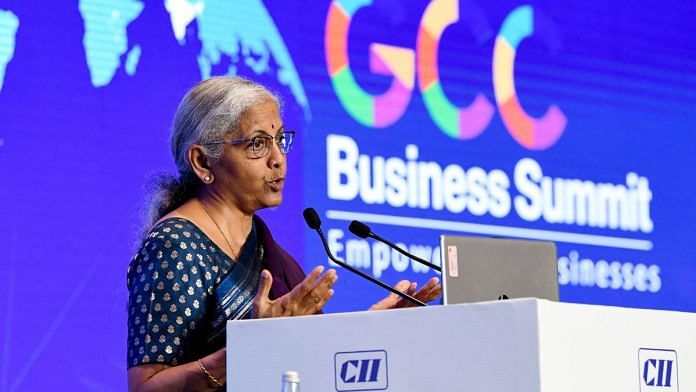Thank you dear subscribers, we are overwhelmed with your response.
Your Turn is a unique section from ThePrint featuring points of view from its subscribers. If you are a subscriber, have a point of view, please send it to us. If not, do subscribe here: https://theprint.in/subscribe/
Every morning, millions of India’s smartest engineers, analysts and managers log in to solve problems. Not for India — but for Fortune 500 giants spread across New York, London, Zurich and Tokyo. They work out of gleaming campuses in Bengaluru, Hyderabad, Gurugram — the shiny temples of India’s booming Global Capability Centres (GCCs).
Estimates suggest there are about 1,800 GCCs in India today, directly employing 2.1 million people. According to Dun & Bradstreet, these centres contribute 2% to India’s GDP — no small feat for an industry that hardly existed two decades ago. The Gross Value Added per capita generated by these centres is an impressive $32,500 — eleven times India’s national average. On paper, this is a poster child of India’s knowledge economy: high-value jobs, big salaries, forex inflows.
But when looked closer, an irony quietly hums under all that air-conditioned success. These millions of highly qualified Indians aren’t solving India’s toughest problems — they’re busy improving efficiencies for corporations domiciled abroad. For most GCC employees, the work is about executing complex mandates (or are they complex?) handed down from global HQs — streamlining supply chains, cutting fraud, improving compliance, tweaking user experience, bettering margins. The result? A sharper bottom line for the foreign parent.
There is no doubt that GCCs have moved beyond the old stereotype of sweatshop back offices. They do high-end work — patents are filed, frameworks designed, new tools built. But here’s the catch: the IP belongs to the parent company. The ownership stays abroad, the tax benefit stays abroad, the real value creation — outside India’s borders.
In a way, GCCs are Brain Drain 2.0 — the brain stays here, but the intellectual capital, productivity and long-term value migrate abroad every time a dashboard is built or a process is optimised. It’s smarter than physical emigration, but the end result feels strikingly familiar: foreign economies leap ahead, while India stays the world’s favourite problem-solver — for someone else’s problems.
This blind spot is rarely debated. Policymakers celebrate FDI inflows, headcount growth, and glittering GCC campuses — but rarely ask whether these global centres seed domestic IP, strengthen local industries or meaningfully spill over into India’s own messy public systems. The irony is that we measure the dollar inflow but ignore the value outflow.
Then there’s the social angle. Most GCC jobs cluster in a handful of urban enclaves, reinforcing the India-1 versus India-2 divide. A well-paid GCC job lifts millions into the urban middle class — but the spillover often stops there. For a young engineer, the dream is clear: a high-rise apartment (oh no! that’s not affordable anymore, even for most of them), a branded car on EMI (this is a must, likely a chunky SUV), weekends in a mall or café chain owned by a foreign PE firm. The same salary that boosts forex reserves often flows right back out — spent on imports or global brands selling to India’s rising consumers.
It’s almost poetic: an engineer in Hyderabad may build AI models that save an foreign insurer millions — then ride home through pothole-ridden roads, dodging inefficiencies that remain starved of the same talent and tools. For many, a GCC job is a passport to comfort — but rarely a chance to build or fix the street they grew up on.
This labour arbitrage is the same old playbook that powered India’s IT boom in the 90s and 2000s. But 30 years on, it’s worth asking: should we still settle for being the world’s efficiency machine?
No one is arguing that GCCs are bad for India — far from it. They train talent, pay well and anchor cities in global value chains. But true self-reliance means going beyond being the world’s back office. If our talent can optimise billion-dollar global operations, why can’t we channel some of that ingenuity to untangle local bottlenecks and wastage? If our best minds file thousands of patents for MNCs, why aren’t we matching that with domestic deep-tech IP?
Maybe the next policy frontier is tying tax breaks and SEZ incentives for GCCs with meaningful domestic spillovers: co-owned patents with Indian startups, mandatory local skill transfer, or open-source tools for public sector bodies. The question isn’t whether India should stop solving global problems — it’s whether we can make sure that the next wave of our talent solves ours too.
India’s GCC story is rightly seen as a symbol of our talent dividend. But that dividend is only fully cashed in when the same talent also fixes India’s biggest, messiest, most local problems — the ones that don’t come with easy billing or foreign patents, but do build a stronger nation.
D&B Report: Economic-Impact-of-Global-Capability-Centers.pdf
These pieces are being published as they have been received – they have not been edited/fact-checked by ThePrint.


